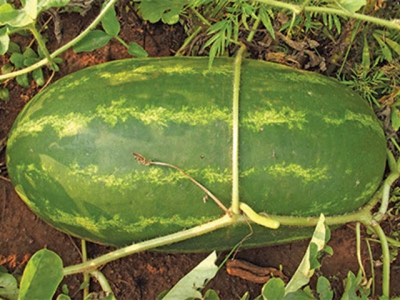Give your watermelons the correct nutrient mix

There are several important considerations when planning a fertiliser programme for your watermelon crop.
A misshapen watermelon with hollow heart.
While watermelons are not particularly sensitive to soil type, sandy loam is best for them. Far more important is good drainage. Standing water and poor aeration are bad for watermelons, even for relatively short periods. This is because they are highly vulnerable to Fusarium wilt, which thrives in conditions of excessive water and poor soil aeration. Use long rotations to reduce the possibility of this disease in subsequent plantings. It’s also essential to plant varieties with Fusarium resistance as there is no immunity to the disease as yet.
Nutrients
Soil pH is not a critical factor, but slightly acidic soil is better. Watermelons can tolerate extremely acidic soil, but in most of the areas where the climate is considered ideal for cultivation in this country, the soil is not highly acidic. The main thing to consider when planting into acid soils is the availability of nutrients. In acid soil, phosphate is often rendered unavailable because it is ‘fixed’ – that is, combined with other elements.
This process can be fairly rapid in some soils and with some forms of available phosphate. In acid soil where this is likely to be a problem, place the fertiliser alongside the plant rows. This concentrates it and ensures less exposure to the minerals, which may render the phosphate unavailable to the plants.
Trace minerals
Apart from phosphate, some trace minerals, such as molybdenum, will be less available in acid conditions. In such cases, apply a foliar spray containing molybdenum and other trace elements as a precautionary measure.
Good nutrition and healthy leaves ensure a good yield and eating quality.
Soil analysis
Your fertilisation plan should, as always, be based on a thorough soil analysis. There is no ‘generic’ fertiliser programme for watermelons – or any crop, for that matter. Each soil and land is likely to have unique requirements, largely determined by natural soil fertility and past fertilisation.
If other crops in the rotation will benefit by increasing the soil pH, you could consider liming. This will also be needed where the soil analysis shows that the calcium level is too low for optimal production. Blossom end rot, which can do substantial damage to the fruit very rapidly, could be a consequence of low calcium. It’s best to have a qualified person analyse the soil and advise you on the nutrients required.
Side dressings
In addition to basic fertilisation, you may need side dressings of nitrogen to promote plant vigour. It’s usually best to apply the first dressing when the plants have started to make runners. Any subsequent dressings will be determined by the plants’ vigour.
Soils with a good organic status require much less nitrogen. Be careful not to over-apply manure as this may provide excessive nitrogen at an advanced stage of plant growth and cause quality problems. You can get away with this on other crops in the cucurbit family, but watermelons can develop hollow heart and a grainy flesh. Hollow heart is often observed as bulges on the fruit, which sound hollow when tapped.
A fine balance
A quality watermelon is a product of balanced fertilisation and sufficient, but not excessive water. Plenty of sunshine and healthy leaves up till harvest will promote tasty, quality fruit. Some farmers neglect to keep the leaves healthy when maturity is near, thinking this will not have much effect on the yield. True, it may not affect the yield at this stage, but without healthy leaves, photosynthesis is reduced. This lowers the sugar content of the flesh, making for a less tasty watermelon.
Boron too
You should also apply boron once or twice to ensure enough is available for the plants. Boron is cheap and easy to apply as a foliar feed; use Solubor at 1kg/ ha per application. Apply one dose when the runners are about 1m long and another at flowering. If you choose to do only one application, do it at the flowering stage.
Related news
Tools

Phối trộn thức ăn chăn nuôi

Pha dung dịch thủy canh

Định mức cho tôm ăn

Phối trộn phân bón NPK

Xác định tỷ lệ tôm sống

Chuyển đổi đơn vị phân bón

Xác định công suất sục khí

Chuyển đổi đơn vị tôm

Tính diện tích nhà kính

Tính thể tích ao




 How to sow salad seeds in guttering
How to sow salad seeds in guttering  An early start to the watermelon season
An early start to the watermelon season